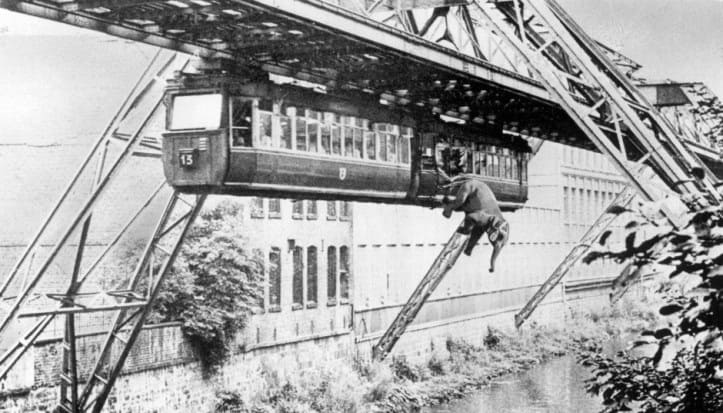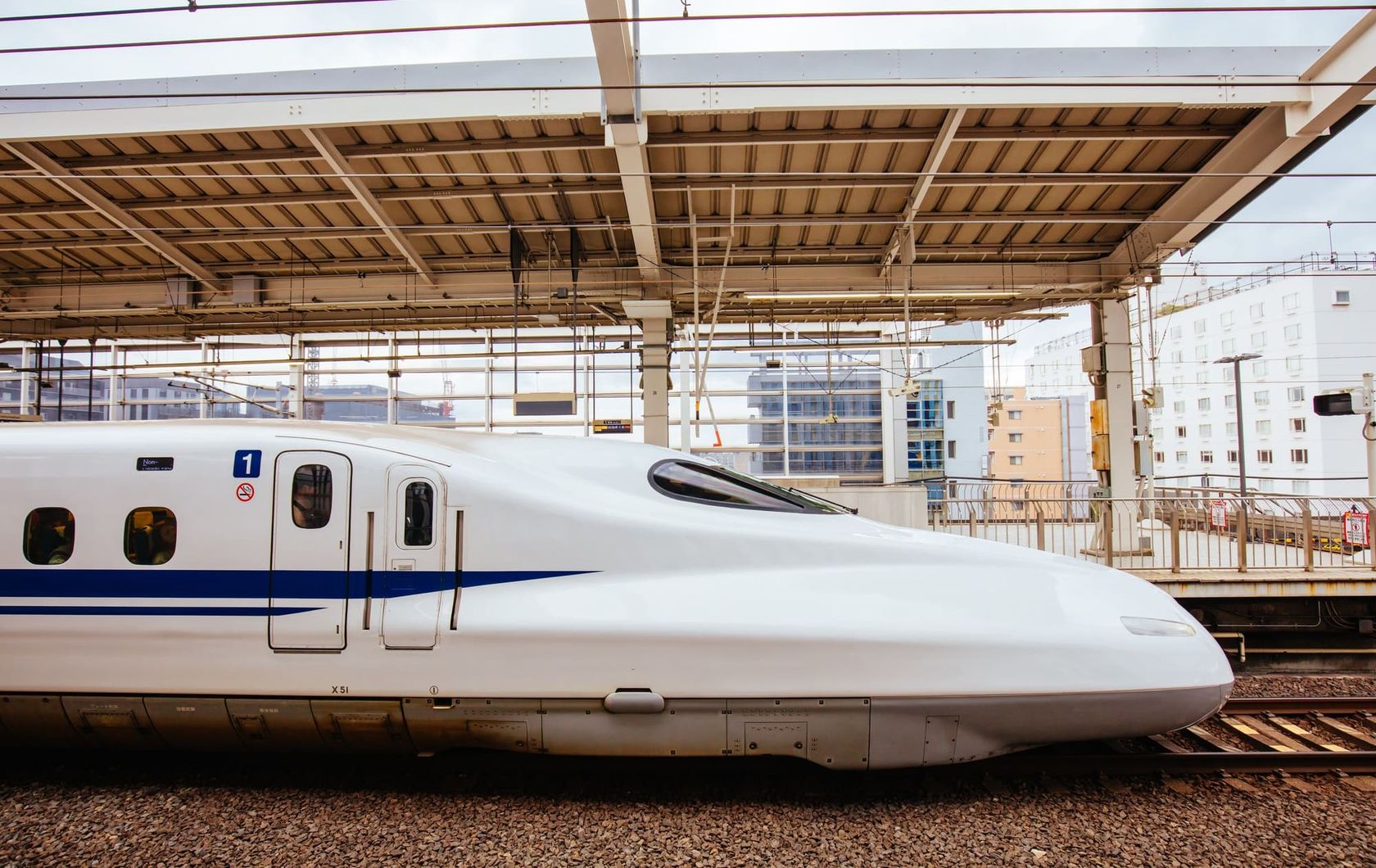Not all of this research has been successful. However, a lot of things that have come into widespread use are incomplete without steel products. And we’re not just talking about metal for producing rails.
First, let's recall a few examples that either turned out to be too strange to be adopted, or are only used under very specific circumstances.
History of non-standard transport
Probably the most unexpected example of rail transport originated in Britain in the late 19th century. An electric tram was launched, running between Brighton and Rottingdean, but it was not a conventional one, rather it went by sea. It looked very much like a daddy long-legs spider and received the same name. The tracks were laid under the sea along the shore. A platform with passengers moved on this 4.5-kilometre track, , which was mounted on high seven-meter steel struts. And the wheeled cars were equipped with devices for cleaning the debris and algae from the rails.
But due to its slow speed, the risk of overturning from the strong waves during rising tides and the difficulties with the construction of wave-breakers, this iron daddy longlegs ran for only five years, from 1896 to 1901. Today, only stone struts, which are visible at low tide, remain as a reminder.
The rack railway is another rail wonder. In general, it is laid in the mountains so that trains can manage routes with a large changes in altitude. To do this, an additional rack rail is laid between a pair of conventional rails. A special gear is installed on the bottom of the train and it clings to this rail and allows the train to safely overcome sharp ups and downs. This type of transport is most popular in the Swiss mountains.
Another place where you can find a rack railway is the Panama Canal. Here, special electric locomotives run along this road that act as land towing cars for huge commercial ships. They are called ‘mules’ after the living mules that worked on this canal separating the two Americas many decades ago.
Nevertheless, there are also more common exotic railroads, which use steel for rails and not just for rails.
Non-standard rails for non-standard roads
The narrow-gauge railroad: Probably, nearly everyone who is interested in tourism has heard about this type of railway. Its main difference from the traditional railway is that it is designed for small-sized locomotives and wagons. In its shape, this railway is a narrow gauge track with small steel rails. Why are the rails like this? Such railways were usually built for industrial purposes on a complex landscape. For example, in the mountains, in order to lower wood on small freight trains. This transport technology was popular until the middle of the 20th century. Over time, more mobile lorries took over the transport of goods on most of these routes. But some mountain railways have not only survived, but become tourist attractions due to the fact that they are laid along picturesque landscapes. The Borzhava narrow-gauge railway is the most famous example in the Carpathian mountains in Ukraine.
At the same time, underground in Donbas and Kryvbas mines, small electric locomotives pull trolleys along narrow-gauge railways. They transport miners to the mine face or bring ore and coal to the surface. After all, a mining dump truck or even a truck cannot be lowered to a depth of several hundred meters.
What do mountain and underground roads have in common? These are special rails that are smaller than standard railroad ones. As a rule, for narrow gauge tracks, rails of the P18, P24, P34 or S20 types are now used. Metinvest Group’s Azovstal Iron and Steel Works produces narrow gauge rails of P24 and P34 types. These are rails with a length of 3 to 12 metres with a mass per one running metre of about 24 and 34 kilogrammes, respectively (hence the designation of products).
For the production of such rails, high-carbon steel grades 50, 60, 70, N50, T60, PT70, etc. are used, as these have an optimal combination of hardness, ductility and wear resistance.
In addition, for laying surface and underground narrow-gauge railways, rails are sometimes used that are intended for mainline railroads of normal and wide gauge. Today, the most popular types of such rails are P50, P65, S49, OP50, OP65 and UIC60. As a rule, steel grades K76, K73F, K74F, K76F, 900A are used for them. Metinvest Group’s Azovstal Iron and Steel Works is the only Ukrainian producer of normal and wide gauge rails.
Steel structures as a way to manage high-density development
Sometimes rail transport needs to be laid where there is no space for it. And even the small dimensions of the narrow-gauge railway do not help. Monorail tracks, located on steel structures, help.
Steel structures are made from plate, section and shaped steel. Depending on the load on the structure, various corners, beams, channels are used, as well as products of a special shape from a heavy plate. For this, flat products are cut, bent, and welded. The result is a reliable support for the monorail.
One of the most famous and effective structure is located in the German city of Wuppertal. Here, more than 13 kilometres of monorail suspension railroad have been laid over the Wupper River and the streets of the city, and it has been operating since 1901. This is surely one example of early experiments that, unlike the daddy longlegs, has become an enduring means of transport.
However, not all of the monorail experiments in Wuppertal have been successful. In 1950, the director of the local circus decided to transport an elephant in a cable car. The adventure ended with the frightened animal breaking through the side and falling from a 12-meter height into the river. Fortunately, the elephant was not injured.

There was a trial to build a monorail in Ukraine. In 2004, an experimental railway appeared, called the "Kapway", in the Kyiv suburb of Hostomel. Its creators had enough strength and capacity for a 300 metre steel structure, along which a bright orange train travelled. Its capabilities have been repeatedly demonstrated to officials in the capital. But, alas, the system has never undergone further development.
Funicular and cable cars
Nevertheless, another exotic type of rail transport has been operating in the capital of Ukraine for over 100 years. It is the funicular that connects the neighbourhood of Podol and Mikhailivska Square. Its peculiarity is that the carriages, which run along a small section of rails on the hillside, work in pairs and are somewhat reminiscent of the weights of old wall clocks suspended on a chain. But on the funicular, the role of the chain is assigned to strong steel ropes made of wire rod and wire. For security reasons, the system is inspected and refurbished annually.
The cable car, which often appears in the movies set on the streets of American San Francisco, works in a similar way. In fact, this is the only tram system of its type that has survived to this day. Here, the cars are also driven by a stationary electric motor located outside the rolling stock. But there is also a difference from the funicular. The cars are not fixed rigidly on a steel rope, but with the help of a special grip, which is uncoupled at stations. Steel ropes are produced in special factories from wire, which, in turn, is obtained from wire rod, one of the main types of long steel products. To get a strong steel cable or rope, strands of wire are wound around a core in a special manner and can be steel, fibrous, solid polymer or combined.
High speed trains – the railway transport of future
The examples of rail transport described above are rather exotic and have has no prospects for being adopted on a mass scale. Yet there is a form of rail transport that has a future. We are talking about high-speed and superfast trains.
For example, the Shanghai Maglev (after MAGnetic LEVitation) is a magnetic levitation train built using German technology. In Shanghai, China, it connects the metro and airport. It is the world's fastest magnetic suspension rail line. The train covers a distance of 30 kilometres in just over 7 minutes, and its maximum speed is 431 km/h. The line has been laid across alluvial soil area on huge reinforced concrete supports. Its base is a special magnetised rail, above which the car ‘hovers’. China is not the only country with such railways. But maglev technology has not yet become widespread due to the high cost of implementation and operation.

More practical is the construction of high-speed and super-fast electric train lines. As a rule, we are talking about speeds of over 140 km/h and 200 km/h, respectively. Such trains provide for the fast and comfortable transportation of passengers between cities of a single or multiple countries. At the same time, high speed means high risk. Therefore, a high level of safety must be provided for such trains.
First of all, we are talking about the need to build separate tracks on which there are no intersections with other train lines, highways and other obstacles. In addition, for high-speed railway lines, special long rails are used, as well as welded rails, standard 25-100-metre rails that are welded together and which form a track with a minimum number of joints. Such welded rails are not only used in Ukraine. For the world's most famous Japanese high-speed trains, Shinkansen, the standard welded rail length is 1,500 metres. And the seamless sections of record length exceed 60km. A bullet train can travel along them at a speed of about 300 km/h.
Will such speeds appear in our country? The Hyundai Rotem and Tarpan passenger trains, which appeared in Ukraine for the 2012 European Football Championship, reach speeds of 140-160 km/h on some sections of Ukrainian Railways (Ukrzaliznytsia). In order to have more such sections and to increase the average speed, it is necessary to constantly modernise the railway lines. It will be even better to build separate tracks for high-speed trains.
Several times, senior Ukrainian officials have announced the development of a feasibility study for a high-speed Euro-track project that would connect Lviv, Kyiv and Odesa. The new train could cover the distance between the capital of Ukraine and South Palmira in 2-2.5 hours. But such a project requires multi-billion dollar investments, and without attracting external investors is practically impossible. Meanwhile, Ukrainian steelmakers are capable of producing steel for rail transport, which can be used not only directly for railway tracks, but also in various units and structures.
